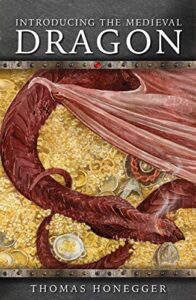The phrase “here there be dragons,” so famously seen on old maps indicating places where there were great and mysterious dangers to be found, was not so very long ago not simply a metaphor. In fact, no less an authority on natural philosophy (what would later become known as natural history) than Linnaeus himself included dragons in the Paradoxa category of the first edition of his Regnum Animale. It was only with his removal of this “ragbag” section in which they had been included from the second edition that the idea that dragons might not actually exist in any physically demonstrable way began to become the norm. And even then, when Miss Anning’s famous paleontological discoveries in the blue lias cliffs of the Dorset coast were brought to popular attention, the question still lingered in the minds of many where they may simply not exist any longer.
In the inaugural volume of the University of Wales Press’ Medieval Animals series, Introducing the Medieval Dragon, Prof. Thomas Honegger provides a concise and very lively introduction to the history of dragons as they were included in the scholarship, religion, folklore, and literature of the European Middle Ages, as well as how such depictions have continued on through the centuries and continue to influence how we often imagine and portray them today.
It is particularly appropriate that Prof. Honegger was chosen to be the author of this volume as not only is he presently professor of English medieval studies at the Friedrich Schiller Universität in Jena, his interest in the creatures of the European medieval bestiary extends back to his doctoral thesis Animals in Medieval English Literature. He is also widely regarded as one of the foremost scholars on the work of someone who himself was interested in medieval dragons and it today renowned for how popular they remain today: the brilliant Oxford philologist and professor of Anglo-Saxon, J.R.R. Tolkien. And it is upon all these bodies of knowledge that Prof. Honegger draws to make this a truly eye-opening as well as particularly informative book.
Beginning with an overview of dragons as physical creatures, Prof. Honegger presents a selection of different descriptions of dragons from the period as well as of explanations of their – potential – biology. It should be noted, as he does, that the dragons under examination in this book are distinctly the European sorts, creatures very different (both physically as well as culturally) from the dragons of China, a point he makes particularly well in his exploration of an artifact identified as the Lucerne chasuble that depicted twin dragons on its large central panel of Chinese silk.
This curious vestment, with its extensively… shall we say “reaching?” explanation of its imagery by its contemporaries, is only one of the examples presented in the presentation of how dragons featured in medieval Christian theology and imagery. For while they were none-the-less considered as physical creatures, they also possessed considerable allegorical power. Appearing as they did in both the Christian Greek canonical and apocryphal scriptures, they were the embodiment of those powerful forces that must be overcome by men and women of particular holiness. Of course, the manner in which they were overcome varied, diverging on one included occasion into their use as an instrument of rather aggressive proselytization in the process of being vanquished.
In addition to their natural (physical) and religious significance, as Prof. Honegger explains, dragons played key roles in the literature and folklore of the European medieval peoples. Drawing upon a number of sources but with particular emphasis on the Anglo-Saxon Beowulf and the Middle English Bevis of Hampton, dragons are examined in their multi-faceted inclusions in both high as well as popular literature and folklore. It is again worth recalling that to the people for whom these stories were contemporary, the challenges and dangers these creatures posed were all too real. However that doesn’t mean that a dragon physically menacing a village could not also serve in an allegorical capacity to remind the readers and hearers of an important religious or social message.
It is uncommon for a single book to have as much potential for being of interest and use to so wide a range of readers as Introducing the Medieval Dragon does. For all those who formally or informally study European medieval history and literature, it should be considered essential reading. Naturalists, particularly those who have an interest in the history of natural history, will also find much that is interesting – as well as surprising – in its pages, which goes as well for those who count intellectual and religious history among their passions. Then of course there are the avid readers of fantasy novels, particularly Tolkien enthusiasts, for whom this book is a must read. And in concluding this list, I would also include modern Vikings (particularly due to the included presentation of the Sigurd / Fafnir story and other saga material), as well as fantasy RPGers, LARPers, and Cosplayers.
 Title: Introducing the Medieval Dragon
Title: Introducing the Medieval Dragon
Author: Dr. Thomas Honegger (Anke Eissmann, illustrator)
Publisher: University of Wales Press (distributed in North America by University of Chicago Press)
Series: Medieval Animals
Format: Paperback
Pages: 144 pp., with multiple illustrations
ISBN: 9781786834683
Published August 2019
Nota bene 1: a very interesting interview with Prof. Honegger by Hilary Wilson can be found in The Folklore Podcast’s Book Club 13 episode.
Nota bene 2: additional volumes in the series take as their respective subjects:
In accordance with Federal Trade Commission 16 CFR Part 255, it is disclosed that the copy of the book read in order to produce this review was provided gratis to the reviewer by the publisher.
